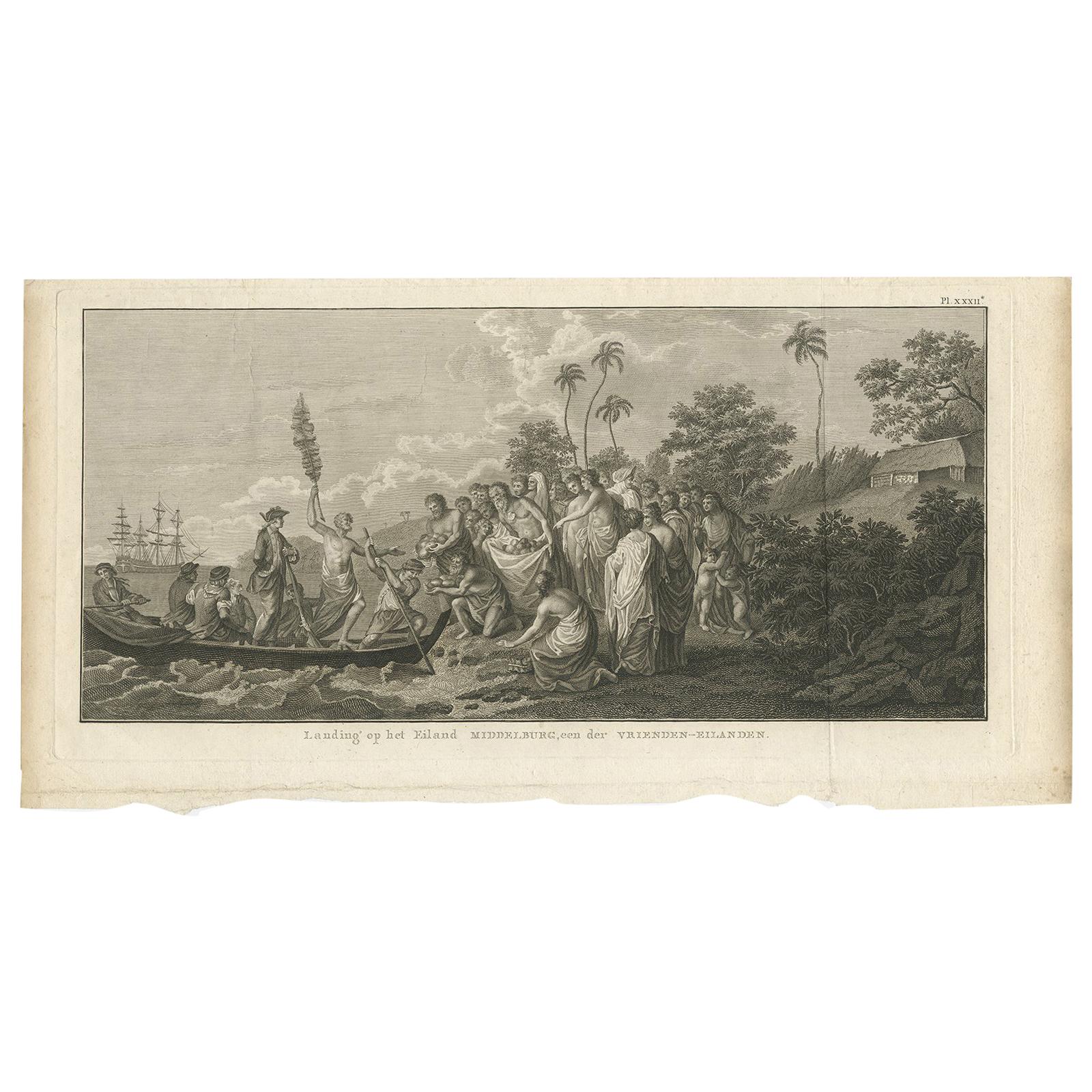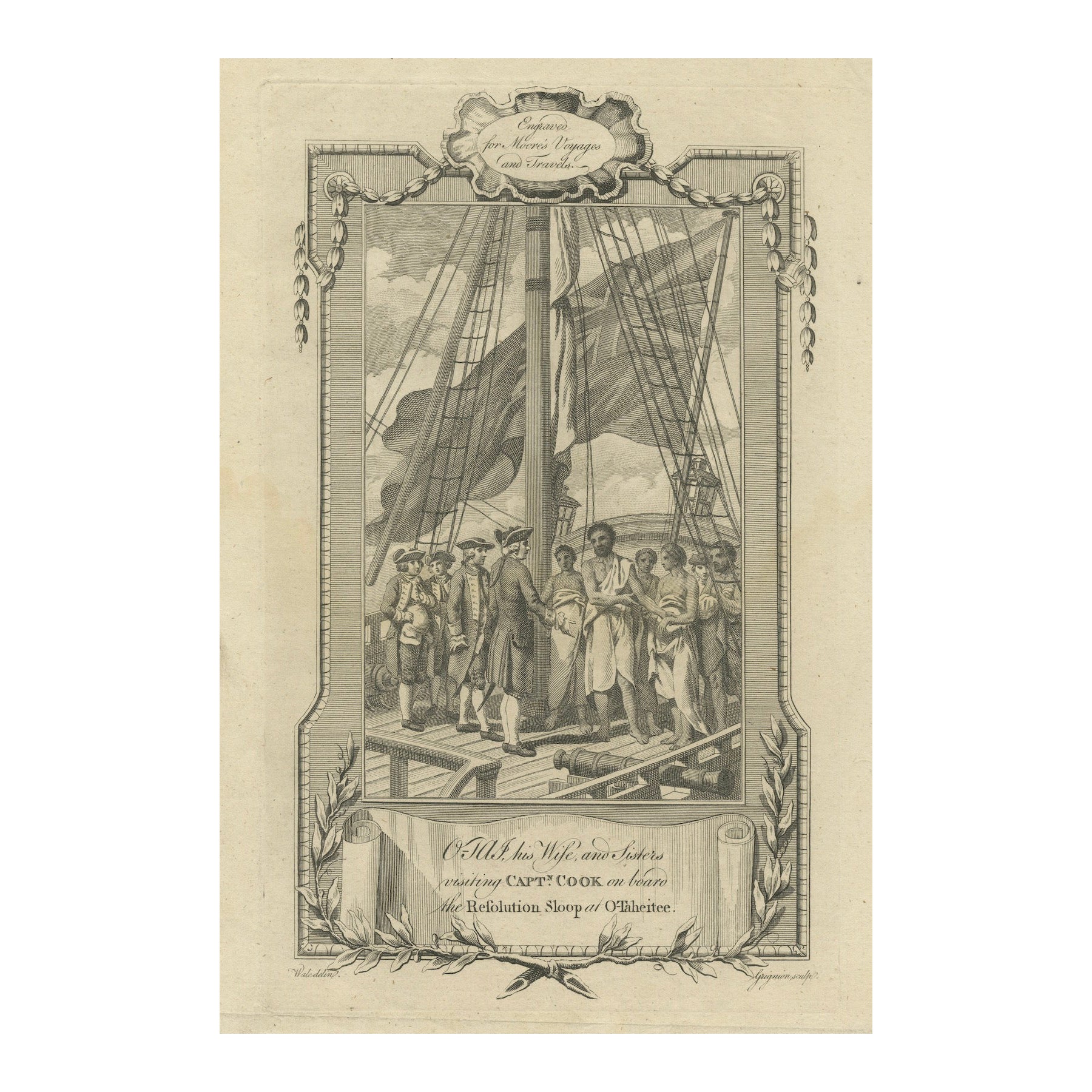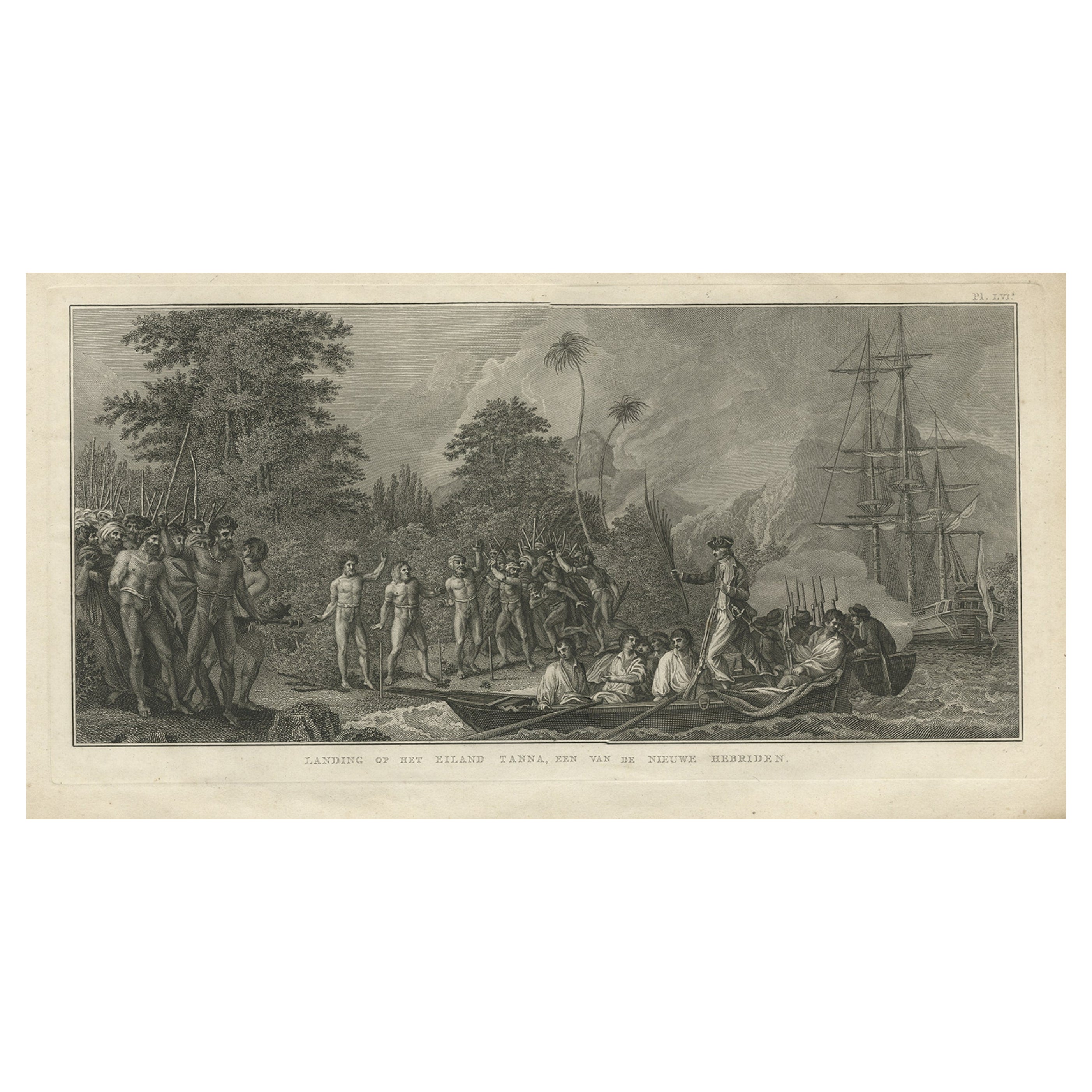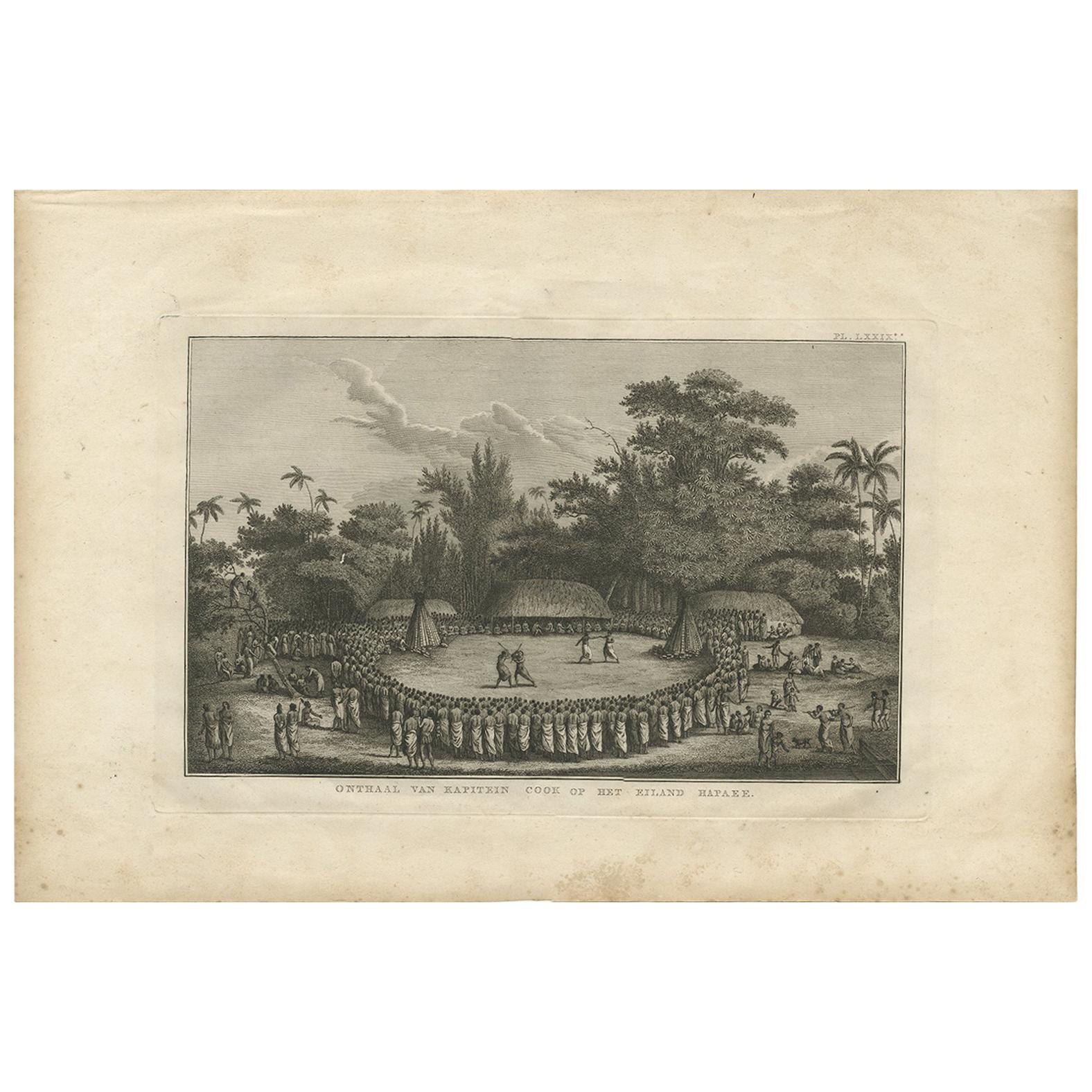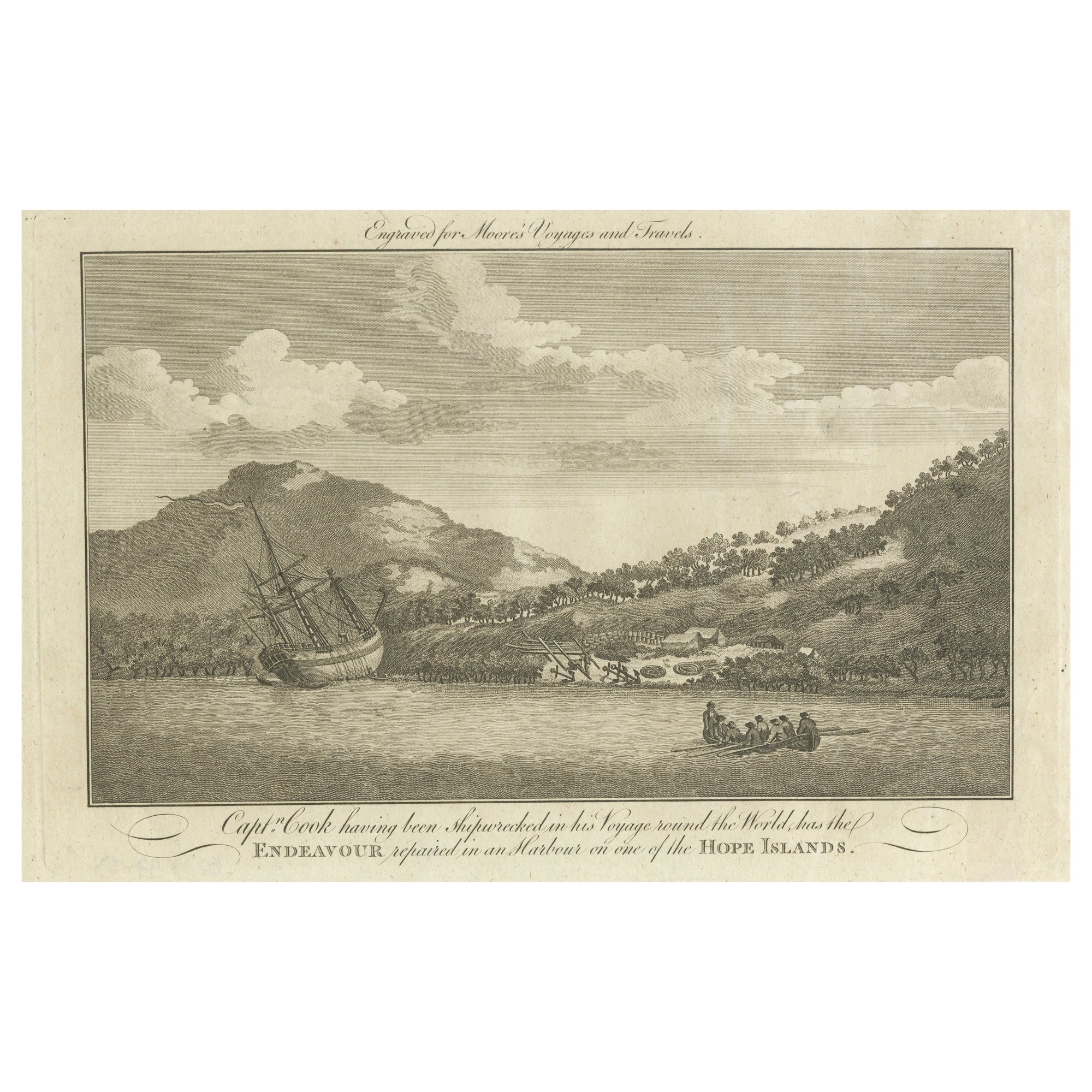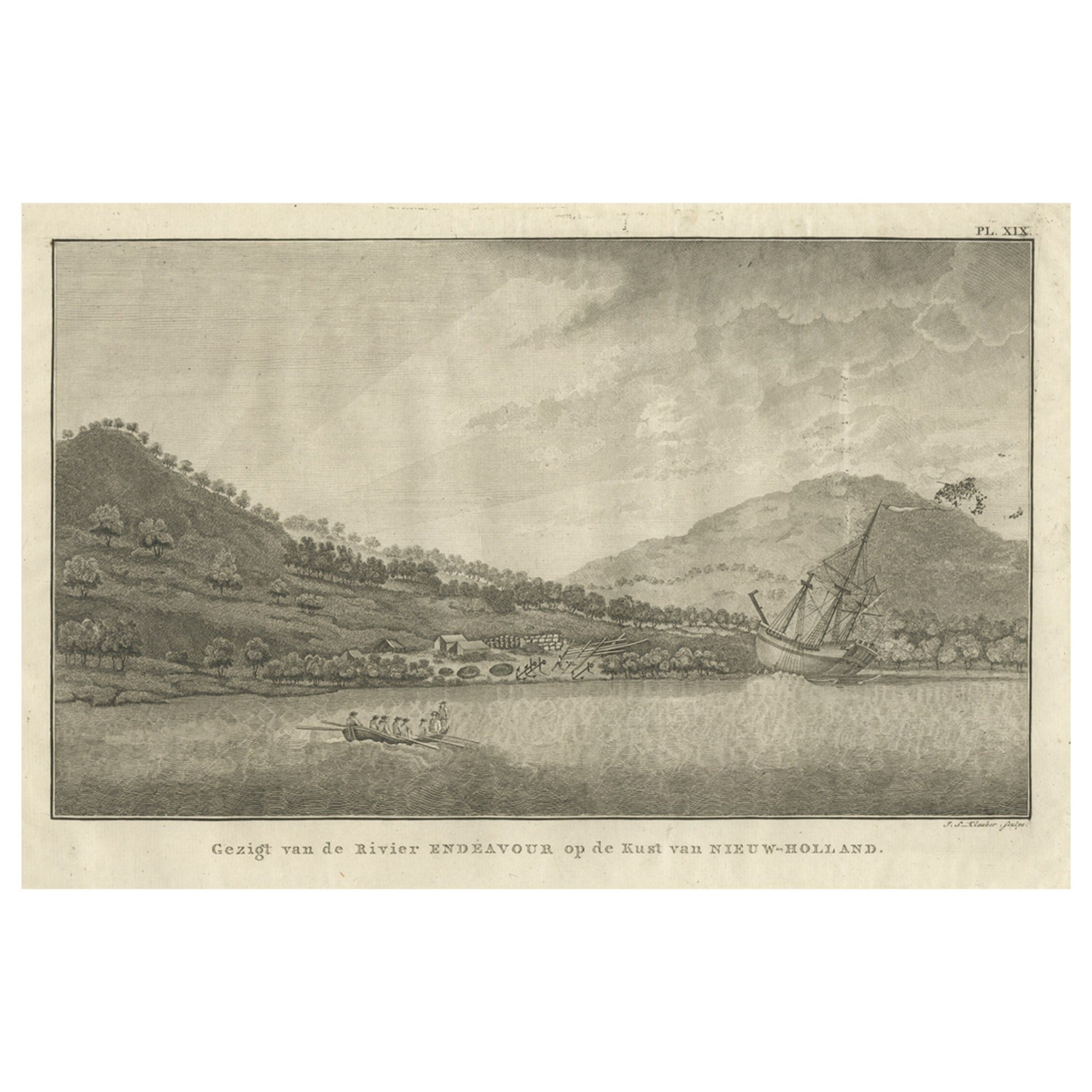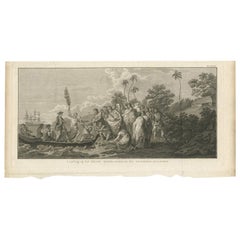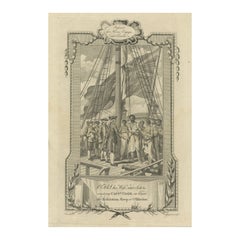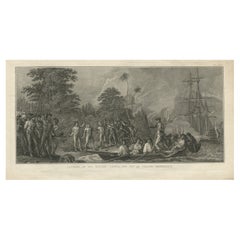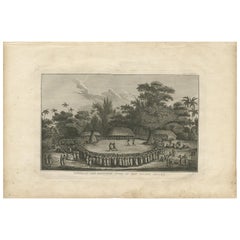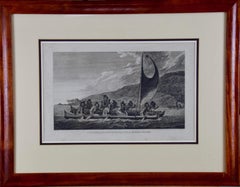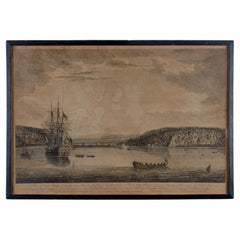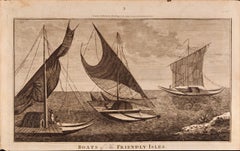Items Similar to Captain Cook's Landing at Middleburgh, Friendly Isles (18th Century Engraving)
Want more images or videos?
Request additional images or videos from the seller
1 of 6
Captain Cook's Landing at Middleburgh, Friendly Isles (18th Century Engraving)
$229.20
$286.5020% Off
£168.86
£211.0820% Off
€192
€24020% Off
CA$315.46
CA$394.3220% Off
A$350.05
A$437.5620% Off
CHF 184.64
CHF 230.8020% Off
MX$4,273.32
MX$5,341.6620% Off
NOK 2,336.07
NOK 2,920.0920% Off
SEK 2,187.92
SEK 2,734.9020% Off
DKK 1,461.52
DKK 1,826.9020% Off
About the Item
An engraving depicting the historical event titled "The Landing of Capt. Cook &c. at Middleburgh, one of the Friendly Isles."
Description:
- The scene shows Captain James Cook and his crew disembarking from a small boat onto the shore of Middleburgh, which is part of the Friendly Isles (now known as Tonga).
- On the left, a group of indigenous people, including men and women, are gathered to welcome the newcomers. The natives are depicted with varying degrees of traditional attire, some wearing cloaks and others appearing partially unclothed.
- The setting includes lush tropical vegetation with palm trees and dense foliage, indicating the island's tropical environment.
- Captain Cook and his men, dressed in European naval uniforms of the 18th century, are shown in the process of stepping onto the land, with one of them raising a ceremonial staff or flag.
- The ocean and a clear sky form the background, highlighting the arrival by sea.
Maker:
- The engraving was published by Alex Hogg, an active publisher in London during the late 18th century. The specific address given is at the Kings Arms No.16 Paternoster Row.
- The publication likely dates to the 1780s or 1790s, a period during which accounts of Captain Cook's voyages were widely disseminated and illustrated.
- Dimensions:Height: 9.65 in (24.5 cm)Width: 14.97 in (38 cm)Depth: 0 in (0.02 mm)
- Materials and Techniques:Paper,Engraved
- Period:1790-1799
- Date of Manufacture:circa 1790
- Condition:Condition: good, given age. General age-related toning and/or occasional minor defects from handling. Please study scan carefully.
- Seller Location:Langweer, NL
- Reference Number:Seller: BG-13599-291stDibs: LU3054340630502
About the Seller
5.0
Recognized Seller
These prestigious sellers are industry leaders and represent the highest echelon for item quality and design.
Platinum Seller
Premium sellers with a 4.7+ rating and 24-hour response times
Established in 2009
1stDibs seller since 2017
2,569 sales on 1stDibs
Typical response time: <1 hour
- ShippingRetrieving quote...Shipping from: Langweer, Netherlands
- Return Policy
Authenticity Guarantee
In the unlikely event there’s an issue with an item’s authenticity, contact us within 1 year for a full refund. DetailsMoney-Back Guarantee
If your item is not as described, is damaged in transit, or does not arrive, contact us within 7 days for a full refund. Details24-Hour Cancellation
You have a 24-hour grace period in which to reconsider your purchase, with no questions asked.Vetted Professional Sellers
Our world-class sellers must adhere to strict standards for service and quality, maintaining the integrity of our listings.Price-Match Guarantee
If you find that a seller listed the same item for a lower price elsewhere, we’ll match it.Trusted Global Delivery
Our best-in-class carrier network provides specialized shipping options worldwide, including custom delivery.More From This Seller
View AllAntique Print of the Landing at Middelburg Island by Cook, 1803
Located in Langweer, NL
Antique print titled 'Landing op het Eiland Middelburg, een der Vrienden-Eilanden'. Print depicting the landing at Middelburg Island, one of the Friendly Islands. Originates from 'Re...
Category
Antique Early 19th Century Dutch Prints
Materials
Paper
$191 Sale Price
20% Off
1778 Engraving: Captain Cook's Second Voyage - Meeting the Tahitians
Located in Langweer, NL
1778 Engraving of Captain Cook's Second Voyage: Meeting Tahitians
This beautiful copper-line engraving from 1778, created by Charles Grignion (1717-1810) after a work by Samuel Wale...
Category
Antique 1770s Prints
Materials
Paper
$229 Sale Price
20% Off
Antique Print of the Landing at Tanna Island by Cook, 1803
Located in Langweer, NL
Antique print New Hebrides titled 'Landing op het Eiland Tanna, een van de Nieuwe Hebriden'. Antique print depicting the landing at one of the islands of the New Hebrides, Vanuatu. O...
Category
Antique 19th Century Prints
Materials
Paper
$515 Sale Price
20% Off
Antique Print of the Arrival of Captain Cook, 1803
Located in Langweer, NL
This antique print depicts the ceremonial welcome received by Captain James Cook upon his arrival at the island of Hapaee (Ha’apai) in Tonga during his third voyage in 1777. The engr...
Category
Antique Early 19th Century Dutch Prints
Materials
Paper
$191 Sale Price
20% Off
Repairing the Endeavour: Captain Cook's Maritime Ordeal at Hope Islands, ca.1770
Located in Langweer, NL
The engraving depicts a scene from one of Captain James Cook's voyages. The text below the image reads: "Capt'n Cook having been shipwrecked in his Voyage round the World, his ship E...
Category
Antique Late 18th Century Prints
Materials
Paper
$343 Sale Price
20% Off
Free Shipping
Captain Cook's Encampment in Australia where The Endeavour was Beached, 1803
Located in Langweer, NL
Antique print Australia titled 'Gezigt van de Rivier Endeavour op de Kust van Nieuw-Holland'.
View of an encampent on the shore of the Endeavour river on the coast of Australia where the Endeavour boat was beached. Originates from 'Reizen Rondom de Waereld door James Cook (..)'.
HMS Endeavour was a British Royal Navy research vessel that Lieutenant James Cook commanded to Australia and New Zealand on his first voyage of discovery from 1768 to 1771.
She was launched in 1764 as the collier Earl of Pembroke, with the Navy purchasing her in 1768 for a scientific mission to the Pacific Ocean and to explore the seas for the surmised Terra Australis Incognita or "unknown southern land". Commissioned as His Majesty's Bark Endeavour, she departed Plymouth in August 1768, rounded Cape Horn and reached Tahiti in time to observe the 1769 transit of Venus across the Sun. She then set sail into the largely uncharted ocean to the south, stopping at the islands of Huahine, Bora Bora, and Raiatea west of Tahiti to allow Cook to claim them for Great Britain. In September 1769, she anchored off New Zealand, becoming the first European vessel to reach the islands since Abel Tasman's Heemskerck 127 years earlier.
In April 1770, Endeavour became the first European ship to reach the east coast of Australia, with Cook going ashore at what is now known as Botany Bay. Endeavour then sailed north along the Australian coast. She narrowly avoided disaster after running aground on the Great Barrier Reef, and Cook had to throw her guns overboard to lighten her. Endeavour was beached on the Australian mainland for seven weeks to permit rudimentary repairs to her hull. Resuming her voyage, she limped into port in Batavia in October 1770, her crew sworn to secrecy about the lands that they had visited. From Batavia Endeavour continued westward, rounded the Cape of Good Hope on 13 March 1771 and reached the English port of Dover on 12 July, having been at sea for nearly three years.
The ship was largely forgotten after her Pacific voyage, spending the next three years hauling troops and cargo to and from the Falkland Islands. She was renamed in 1775 after being sold into private hands, and used to transport timber from the Baltic. Rehired as a British troop transport during the American War of Independence, she was finally scuttled in a blockade of Narragansett Bay, Rhode Island in 1778. Historical evidence indicates the ship was sunk just north of Goat Island in Newport Harbor, along with four other British transports.
Relics from Endeavour are displayed at maritime museums worldwide, including an anchor and six of her cannon. A replica of Endeavour was launched in 1994 and is berthed alongside the Australian National Maritime Museum in Sydney Harbour. The NASA Space Shuttle...
Category
Antique Early 1800s Prints
Materials
Paper
$522 Sale Price
40% Off
You May Also Like
Sandwich Islands Canoe (Hawaii): Framed 18th C. Engraving Captain Cook's Journal
By John Webber
Located in Alamo, CA
"A Canoe of the Sandwich Islands, the Rowers Masked" is an engraving created by Charles Grignion, from a drawing by John Webber (1752-1793), who was the artist on Captain James Cook's 3rd and final voyage of discovery. It is Plate 65 in the atlas of "A Voyage to the Pacific Ocean Undertaken by the Command of His Majesty, for Making Discoveries in the Northern Hemisphere", the official British Admiralty sanctioned journal published upon completion of the voyage in London in 1784 by Strahan & Cadell.
This famous image of ten Hawaiian rowers transporting a priest who is carrying a feather-covered image of Kukailimoku, the Hawaiian god of war. The priests and paddlers are all wearing gourd masks in their double-hulled canoe with an upright lateen woven sail. Each hull was shaped from a single large Koa log harvested from island rainforests, where they were carved before being transported to the coast.
This engraving is presented in a Koa wood frame and a white mat. There are occasional faint spots, but the print is otherwise in very good condition. Koa is the same wood as was used to make the canoe. Koa wood is legendary in Hawaii. Not only is this amazing wood native to Hawaii, but it is known for the deep rich colors and varied grain pattern. Koa has an honored heritage in Hawaii and is highly revered and sacred. The word “koa” means “warrior” in Hawaiian. The warriors of King Kamehameha the Great, created canoes and weapons from a wood plentiful on the Big Island of Hawaii. This wood became synonymous with the warriors themselves, and it became known as koa. The frame measures 20.75" high, 26.75" wide and 0.88" deep.
There are three other engravings listed from the official journal of Captain Cook's 3rd voyage available that are presented in identical Koa wood frames and mat (LU117324682022, LU117324684052, LU117324684062). They would make a wonderful grouping for a display of 2, 3 or 4 prints. A discount is available for a grouping depending on the number of items included.
Hawaii was discovered by Captain Cook (1728-1779) during this voyage. Hawaii was originally called The Sandwich Islands in honor of The Earl of Sandwich...
Category
1780s Landscape Prints
Materials
Engraving
Reception for Captain Cook, Tonga: Original 18th C. Engraving, Cook's 3rd Voyage
By John Webber
Located in Alamo, CA
"The Reception of Capt. Cook in Hapaee" is an original 18th century engraving from a drawing by John Webber (1751-1793), who was the artist who accompanied Captain Cook on his third ...
Category
1780s Landscape Prints
Materials
Engraving
A View of Cape Rouge, Quebec, Canada, Mazell after Capt. Hervey Smyth, c.1760s
Located in Savannah, GA
A View of Cape Rouge, or Carouge, on the Saint Lawrence River, north of Quebec.
Engraving by Peter Mazell after a drawing by Captian Hervey Smyth, published c.1760's, London.
T...
Category
Antique 1760s Canadian British Colonial Prints
Materials
Paper
Boats of the Friendly Isles, Tonga: Original 18th C. Engraving from Captain Cook
By William Hodges
Located in Alamo, CA
"Boats of the Friendly Isles" is an original 18th century engraving from a drawing by William Hodges (1744-1797), who was the artist who accompanies Captain Cook on his second voyage...
Category
1780s Landscape Prints
Materials
Engraving
An Inland View; in Atooi ( Hawaii ) 1784 Captain Cook engraving by John Webber
By John Webber
Located in Paonia, CO
An Inland View in Atooi ( Hawaii ) is from the 1784 First Edition Atlas Accompanying Capt. James Cook and King; Third and Final Voyage of Captain James Cook. This engraving depicts ...
Category
1780s Realist Landscape Prints
Materials
Engraving
Surrender of Tahiti to Captain Wallis: An Original 18th C. Engraving
By John Webber
Located in Alamo, CA
"A Representation of the Surrender of the Island of Otaheite to Capt.n Wallis, by the Supposed Queen of Oberea" is an original 18th century engraving created by Sparrow, from a drawi...
Category
1780s Landscape Prints
Materials
Engraving
More Ways To Browse
19th Century Bronze Stag
19th Century Carved Hutch
19th Century Chinese Bronze Urns
20th Century Terracotta Plates
70s Pillows
8 Foot Mirror
African Sculpture Antelope
African Wood Bed
Alfredo Barbini Fish
American Of Martinsville Chest Of Drawers
Anatomical Eye
Angel Putti Sculptures
Antique Bronze Hare
Antique Bronze Sink
Antique Bugle
Antique Campaign Writing Slope
Antique Cast Iron Toy
Antique Chinese Hat Stand
